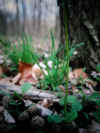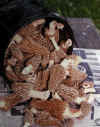| April (written
2005)
When Indiana and other midwestern states awaken from a winter of slumber,
there are a blue million activities that beckon outdoors types. Making
decisions on how to spend those blissful April days can be tough, but not
for those who mix and match their pleasures according to what is available.
Mix and match outdoorsing has been a way of life for many Hoosiers in
the fall when Mother Nature’s summer labors are coming to a head. Fewer
of the outdoor set have applied this principle to the spring--more specifically
April--when the old gal’s works are starting.
Although those who fish in April may outnumber morel hunters, parlaying
a fishing trip with a morel hunt can be as exciting as life gets. Throw
in the simple enjoyment of wildflowers, birds and other wild critters and
you have a great experience to charge against a day.
Then, of course, there is the possibility of throwing in a daylight
turkey hunt for good measure, not to mention collecting the prime ingredients
for a delicious dish of greens, or harvesting pokeweed spears for frying
(poor man’s morel in Southern Indiana).
April adventures translate into days of discovery for me. And
though I may think I have been there, done that, I learn something new
about the wild every time I take to wood and stream in April. Although
we of the outdoor fraternity usually take to the outdoors with one--or
possibly two or three activities--in mind, it often is the discovery of
incidentals that make the day. The spring outdoorsman should be equipped
to handle many situations.
The point is well illustrated by fishing trip gone awry many years ago.
It was a beautiful late-April day and many members of the family had
gathered for dinner at our house. After dinner--as it was wont to do--full
tummies brought naptime for some while others groggily whiled away this
beautiful day watching TV.
“There must be something better for me to do under such circumstances,”
I said to myself, grabbing a five-gallon bucket, a little spinning rod,
and a shirt-pocket-sized plastic box (a soap box) of small artificial lures.
I would not be missed, I told myself, adding that I would like to go catch
some bluegills to stock in my front-yard pond.
Soon thereafter I arrived at the place where I would catch the bluegills.
But to get to the pond, I had to walk through a quarter of a mile of beautiful
wooded morel country.
Striking out down a rough trail, I noticed the cap of a huge yellow
morel lying beside its stem in the trail. Somebody kicked the cap off the
stem without seeing it, I thought, knowing that I was duty bound to harvest
this beautiful work of nature and use it.
While bent over to pick up the mushroom cap and twist off its stem,
my peripheral vision spread before me a blanket of huge yellow morel that
covered the woodland floor. That ended the fishing for that day. When darkness
engulfed the little woods, the five-gallon bucket and two plastic bags
that must have held almost as many morels, were full.
Spring foragers, as those of the fall, can’t always know in advance
what they will encounter on a trip to the wild. But those who are prepared
to harvest the many products of nature will be successful.
For example, one day last spring while on a mushroom hunt that offered
a wildflower bonanza, I ran smack’-dab’ into a beautiful patch of stinging
nettle on a damp, gently-sloping hillside on the banks of a small creek
that bisected a heavily wooded area. The dark green nettles, five or six
inches tall, had yet to develop the little spines that cause the human
skin to itch.
Many foragers would have passed on the chance to collect these delicious
greens for fear of getting a case of itchy hands and fingers. I pulled
a bread sack and a pair of scissors out of the back of the shooting vest
I almost always wear on my spring outings, and filled the sack with the
prime ingredient for a beautiful, nutritious dish of greens.
Later I would rinse the green leaves and tender stems in cold, running
water at the kitchen sink and slowly cook them (covered) in a cup of homemade
chicken broth with a bit of chopped onion and morels. When the onion was
tender, I drained off the excess liquid and creamed the mixture to create
a dish that well complemented a dinner of fried bluegill filets. Note:
A hard-boiled boiled egg sliced over the greens and a sprinkling of a favorite
grated cheese will not dim the taste of this dish. Stinging nettles look
very much like spinach when cooked, and in my book they are just as tasty.
There are, of course, literally dozens of other plants that can be combined
--or cooked alone--to turn into tasty table fare. When cooking such plants,
it is a good idea to change the water, or broth, two or three times to
eliminate any toxic qualities the plants might contain.
Now, about those spring morels.
When March turns to April--or even before--I am besieged with questions
concerning spring mushrooms. Folks want to know the wheres, whens, and
hows of mushroom hunting.
Questions on when to hunt morels probably outnumber all others, and
I most often say the best guide is wildflowers. However, such a statement
hinges on weather conditions, especially rain.
The importance of adequate moisture in the earth and warm air temperatures
are well illustrated by last year’s weather conditions in central and southern
Indiana. In the central part of the state last year there had been little
rain when warmer air temperatures came. Morels were scarce and most were
small.
When rain appeared to be the spring morel’s savior, air temperatures
turned cool--even cold--and bets for a good morel season were off. At the
same time, warm, sunny days combined with good rains, and the spring morel
season was very good--big finds of big mushrooms.
Water and weather conditions right, I start looking for morels--small
grays and blacks--when spring beauty (Claytonia virginica) covers
forest floors with blankets of pinkish white. When this beautiful wildflower
starts developing seedpods, it is time for big yellow morels, even the
long-stemmed woods morels.
The emergence of big yellow morels--even big grays--also is heralded
by the lavender bloom of lilac bushes, a lawn fixture of many older homes.
Another good spring morel barometer is the flowers of look-alike beauties
bloodroot and twinleaf. When
their eight-petaled flowers peak in their beauty, big grays and yellows
(yallers) are nigh. When they develop their inch-long green seedpods those
mushrooms are going over the hill into Michigan and other venues to the
north.
This barometric tendency of wildflowers to indicate the presence of
morels brings to mind the question I have heard for many years: Do morels
grow in patches of Mayapple?
Based on my own observations of this matter, I always answered the question
with a terse, “Of course not! What kind of silly notion is this?”
Some 20 years ago my tune changed. As I approached a large patch of
Mayapple in my favorite mushroom woods I told myself there was no point
in looking there. But as I skirted the patch my eyes settled on a huge
yaller . . . nestled beneath the green umbrella of what else . . . a Mayapple.
So where does one look when visions of a skilletful of well-browned
morels occupy cerebellums?
The late Chuck Weatherwax, Bloomington sage of morel wisdom, put the
answer to this important question in perspective (and verse) many years
ago when he sent me the following:
“The thing that you’ve got to remember . . .
About mushroom hunting is that . . .
There ain’t no point in looking . . .
Until you’re where they’re at.”
I never met Chuck, but have always thought of him as a kindred spirit.
Where do you look for morels?
You look first around dead Dutch elm trees that are shedding their bark,
in apple orchards, and around many other species of trees; especially you
look around trees with loose bark or limb structures that offer resistance
to the flow of air.
An old morel-hunter theory holds that the spores (microscopic seeds)
of morels are carried by the wind. The rationale indicates that loose bark
of dead elms and the thick configuration of limbs and twigs of some trees
slows the flow of air and spores drop to the earth where they develop as
mushrooms in subsequent years.
Thus, yet another axiom of morelling comes into play: mushrooms, like
bass, squirrels, and other children of nature, are where you find them.
However, this does not preclude the fact that my findings of many years
in the mushroom woods indicate a good, general ability to identify trees
at a distance will help fill your poke with morels.
Some of my favorite trees are sycamore, yellow poplar (tulip tree,
Indiana state tree) ash, hickory and American beech. But I am not just
exactly flabbergasted when I find a patch of morels in an area that contains
none of the above.
And while tracts of big woods have always seemed prime mushroom habitat
to many mycologists, sparse growth of saplings can produce. The thinking
here is that this kind of canopy lets in more sunlight than does thick
stands of larger trees.
So you’ve done it. You have gone out and found the mother lode of morels.
The next question is what do you do with them?
The quick answer to that question is: PLENTY!
Not to mention consuming, mushrooms may be frozen, dried, or canned
for future use. These and many other columns related to mushroom hunting
can be found via the search engine
of this web site. Just type in “mushroom’ and you will find columns
covering many aspects of this most-interesting outdoor activity.
Click
on thumbnail image for enlarged view.

|
(Left) This patch of little gray beauties lived near
a large dead elm tree. |
| (Right) Big grays and yellows more than filled this five-gallon
bucket. |

|

|
(Left) Slipping bark of a dead elm tree indicates morels
may be nigh. |
| (Right) This patch of stinging nettles turned into a
great dish of greens . . .Get them when they are young. |

|

|
(Left) This pix will help new poke-shoot gatherers identify
old and new growth. New growth comes up at the same places every year from
tuberous roots. |
| (Right) Fried poke shoots are known as “the poor man’s
morels” in Southern Indiana. |

|
|

